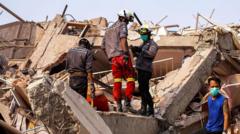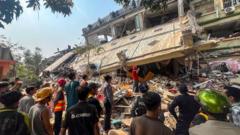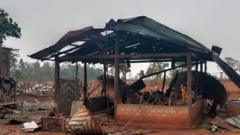The recent 7.7-magnitude earthquake that struck near Mandalay has caused a grave humanitarian crisis. The official death toll reported by Myanmar's military government has reached 694, with injuries surpassing 1,600, and projections suggest the toll could climb much higher.
Myanmar Earthquake: Death Toll Soars and International Aid Challenges Loom

Myanmar Earthquake: Death Toll Soars and International Aid Challenges Loom
A powerful earthquake in Myanmar has left nearly 700 dead as it disrupts the region, prompting urgent global responses.
The earthquake, occurring on March 28, 2025, significantly impacted the areas bordering the Sagaing Fault, regions that have previously been vulnerable to seismic activity. The devastating effects were felt not only across Myanmar but also in neighboring countries such as Thailand, Bangladesh, and southern China. An appeal for international aid from Myanmar’s isolated military government signals the dire humanitarian situation, desperately needing assistance amid severe logistical challenges.
Rescue operations are hindered by ongoing sanctions against the junta, and the potential for the military to manipulate aid delivery. Previous crises in Myanmar highlight risks that aid could be restricted to regions loyal to the military. International aid organizations face barriers from the junta, while the country’s communication blackouts make it difficult to assess damage fully.
Experts predict the casualty figures could be devastating—with estimates suggesting at least 10,000 fatalities may occur, given that many buildings in Mandalay and surrounding regions are not structurally sound. With frayed infrastructure, the plight of survivors trapped under rubble, and the complexities of aid logistics, the coming days might bring further tragedies.
Furthermore, historical context reveals that Myanmar is located in a seismically active area, often experiencing earthquakes; in 2011, another quake resulted in significant loss of life and destruction. As the world watches, the region braces for the unfolding recovery process, amid elevated concerns that the fallout from this earthquake may exacerbate the existing humanitarian crisis.
Rescue operations are hindered by ongoing sanctions against the junta, and the potential for the military to manipulate aid delivery. Previous crises in Myanmar highlight risks that aid could be restricted to regions loyal to the military. International aid organizations face barriers from the junta, while the country’s communication blackouts make it difficult to assess damage fully.
Experts predict the casualty figures could be devastating—with estimates suggesting at least 10,000 fatalities may occur, given that many buildings in Mandalay and surrounding regions are not structurally sound. With frayed infrastructure, the plight of survivors trapped under rubble, and the complexities of aid logistics, the coming days might bring further tragedies.
Furthermore, historical context reveals that Myanmar is located in a seismically active area, often experiencing earthquakes; in 2011, another quake resulted in significant loss of life and destruction. As the world watches, the region braces for the unfolding recovery process, amid elevated concerns that the fallout from this earthquake may exacerbate the existing humanitarian crisis.






















